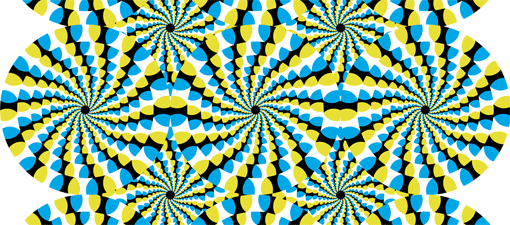


 |
||
 |
||
|
Look at the picture. Do the rings appear to be rotating? The key to the illusion is the non-symmetrical sequence of colors that make up the rings. Each ring seems to be rotating with the blue part taking the lead. (Yet the illusion depends on the asymmetry of the color shades, not on any particular color). This is an example of a fixed movement illusion: the stimulus is fixed in place but appears to be moving. Therefore, the illusion most likely affects a mechanism in the eye or brain that is responsible for identifying movement (see the Expert Brain displays). We know that mechanisms specializing in movement compare the timing of different stimuli to draw conclusions about movement in general. For instance, if we see a point of light flash, first on the left and then on the right, the brain might assume the point is moving from left to right or that there are two different points of light flashing at different times. A third possibility, that the point of light is moving from right to left, is not reasonable. On the other hand, when we see a stable picture, we would expect the brain cells analyzing that picture to operate at approximately the same time and therefore "decide" that they do not identify any movement. So why does illusion take place? The answer seems to lie with the tendency of cells in the visual areas of the brain to react more quickly to stimuli with a high level of contrast (very light and very dark, for instance) than to stimuli that are more similar. As a result, there is a time difference in cell reactions to different parts of the pictures, and these time differences are mistakenly perceived as a hint of movement. Recent research provides evidence that cells in the primary visual area of the brain - and, more importantly, from the MT area responsible for movement - are tripped up when presented with the illusion and behave as if they are witnessing real movement. Related exhibit: Link:
|
||

 Rotating Rings
Rotating Rings